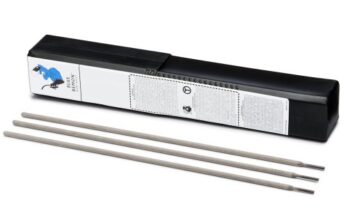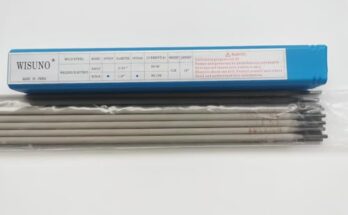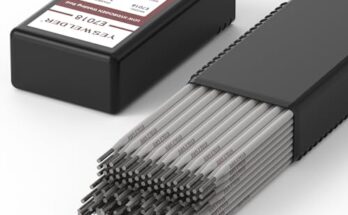Looking to understand the ins and outs of e309 welding rod? This comprehensive guide will walk you through everything you need to know, from its composition and applications to its advantages and disadvantages. We’ll explore various scenarios and offer practical advice, helping you become confident in using this versatile welding material.
Understanding E309 Welding Rods: A Comprehensive
Guide
Let’s delve into the world of E309 welding rods. Before we get started, a quick note: this is not a comprehensive guide intended for certified welders. This aims to provide a general understanding and safe handling information. Always consult a qualified professional for complex welding tasks or if you lack experience.
What is an E309 Welding Rod?
An E309 welding rod is a type of consumable electrode used in gas metal arc welding (GMAW) or shielded metal arc welding (SMAW) processes. Its key characteristic lies in its composition, a chromium-nickel stainless steel alloy. This alloy grants it excellent corrosion resistance and high strength, making it suitable for a variety of applications. The “E” in E309 designates it as an electrode, and the “309” refers to its specific chemical composition, indicating the percentages of chromium and nickel. Think of it like a special type of metal glue, meticulously crafted to create strong and durable welds in specific materials.
The specific composition is typically around 23-27% chromium and 11-14% nickel. These elements give the weld metal superior resistance to oxidation and corrosion, important when dealing with environments exposed to harsh weather conditions, chemicals, or high temperatures. It’s not just about strength; it’s about longevity and resilience against degradation.
Key Features and Properties of E309 Welding Rods
E309 welding rods boast several key features that set them apart. Its high tensile strength and resistance to corrosion are particularly attractive for applications requiring exceptional durability. The weld created using this rod exhibits good ductility and impact resistance, ensuring a long lifespan. The weld metal’s ability to resist cracking under stress is also a crucial property. Imagine building a structure exposed to vibrations – the resistance to cracking is paramount to the structure’s safety.
The weld’s resistance to heat and corrosion is also a standout feature. This is particularly valuable in industries where high temperatures or harsh chemical exposure are common. Unlike some other welding rods that might weaken or corrode under such conditions, E309 maintains its integrity, ensuring the long-term reliability of the weld. This versatility makes it a preferred choice across numerous applications.
Applications of E309 Welding Rods
The versatility of E309 welding rods makes them suitable for a wide range of applications. They are frequently used in joining austenitic stainless steels, a type of steel known for its corrosion resistance and non-magnetic properties. Common examples include welding stainless steel pipes in chemical plants, food processing equipment, or even parts for medical devices. It is crucial to ensure the correct welding technique and safety precautions are followed.
Consider a scenario where you are repairing a stainless steel exhaust system on a vehicle. The high-temperature resistance of E309 ensures the weld doesn’t weaken or fail under the extreme heat generated by the engine. Or picture a crucial pipeline carrying corrosive chemicals; the weld’s resistance to chemical attack is essential to avoid leaks and potential environmental hazards. The correct application of E309 can prevent costly repairs and safety risks.
Comparing E309 Welding Rods to Other Types
E309 vs. E308 Welding Rods
While both E309 and E308 welding rods are used with stainless steel, they have key differences. E308, another popular stainless steel welding rod, contains a slightly lower percentage of chromium and nickel. This results in a weld with lower corrosion resistance compared to E309, particularly in harsh environments. E309 is generally preferred when high corrosion resistance is paramount.
Imagine you need to weld stainless steel components for a seawater desalination plant. The constant exposure to salt water demands exceptional corrosion resistance. In this scenario, E309’s higher chromium and nickel content would make it the more suitable choice, ensuring the long-term durability and integrity of the weld. Conversely, in less corrosive applications, E308 might be an economical alternative.
E309 vs. Other Stainless Steel Welding Rods
Various stainless steel welding rods are available, each designed for specific applications. The choice often depends on the base metal’s composition and the operating environment. Some rods might offer higher strength but lower corrosion resistance, while others might be easier to weld but less durable. Understanding these nuances helps welders select the right rod for optimal results.
For instance, a project requiring extremely high strength might benefit from a welding rod with a higher carbon content, even if it compromises slightly on corrosion resistance. On the other hand, applications demanding superior weldability, especially in challenging positions, might necessitate a different type of welding rod. The key is understanding the trade-offs involved in selecting a specific rod.
Factors to Consider When Choosing E309 Welding Rods
Selecting the Right Diameter
The diameter of the E309 welding rod influences its ability to deposit the required weld metal efficiently. Thinner rods are better for precise work and filling small gaps, while thicker rods are more suitable for larger welds or those requiring faster deposition rates. The choice depends on the project’s specific requirements and the welder’s preference.
Consider the application: repairing a small crack in a stainless steel component would require a thinner rod to make the repair precise and prevent excess weld material. Conversely, building a substantial stainless steel structure would necessitate thicker rods to complete the job quickly and efficiently.
Considering the Welding Process
E309 welding rods can be used with various welding processes, each affecting the weld’s characteristics. Gas Metal Arc Welding (GMAW), also known as MIG welding, allows for fast and efficient welding, ideal for large-scale projects. Shielded Metal Arc Welding (SMAW), or stick welding, offers more control for precise work in hard-to-reach areas. Understanding these differences helps in choosing the appropriate technique.
If speed and efficiency are priorities, GMAW would be the preferred choice. However, if precise control and work in confined spaces are needed, SMAW is more suitable. Each process offers distinct advantages and limitations, and selecting the right method for the given application is critical for success.
Safety Precautions When Using E309 Welding Rods
Personal Protective Equipment (PPE)
Safety should always be the top priority when working with E309 welding rods. Appropriate Personal Protective Equipment (PPE) is essential. This includes a welding helmet with a suitable shade lens to protect eyes from harmful ultraviolet radiation and intense light, welding gloves to prevent burns and protect hands, and flame-resistant clothing to shield the body from sparks and hot metal. Eye and lung protection are non-negotiable.
The consequences of neglecting PPE can be severe, ranging from minor burns to significant eye damage or respiratory problems. Investing in high-quality PPE is an investment in your safety and well-being. It is crucial to always prioritize safety over speed or convenience.
Ventilation and Workspace
Welding generates fumes and particles that can be harmful if inhaled. Adequate ventilation is crucial to maintain a safe working environment. Working in a well-ventilated area or using an extraction system helps remove harmful fumes. Additionally, ensuring a clean and organized workspace minimizes the risk of accidents and ensures smooth workflow.
A poorly ventilated workspace increases the risk of inhaling harmful fumes, leading to respiratory problems. A cluttered workspace increases the likelihood of accidents caused by trips or falls. Maintaining a safe working environment is vital for both the welder’s health and the overall efficiency of the welding task.
Troubleshooting Common Issues with E309 Welding
Porosity in E309 Welds
Porosity, the presence of small holes in the weld, is a common issue that can weaken the weld and compromise its integrity. This often results from insufficient shielding gas coverage, moisture contamination of the welding rod or base material, or improper welding technique. Addressing these factors can significantly reduce porosity.
Careful attention to the welding technique, proper gas flow rate, and ensuring the welding rod and base material are thoroughly dried can largely prevent porosity. Identifying the root cause and taking corrective actions are key to achieving high-quality, defect-free welds.
Cracking in E309 Welds
Cracking, another common issue, typically occurs due to excessive stresses within the weld metal during cooling. This can be caused by too rapid cooling, or by the presence of impurities in the base metal or welding rod. Preheating the base material or using a proper welding technique helps prevent cracking. In rare cases, it may indicate incompatibility between the welding rod and the base metal.
Understanding the reasons for cracking helps in adopting preventive measures. Proper preheating, optimized welding parameters, and using a suitable welding technique can significantly reduce the chances of weld cracking.
Frequently Asked Questions
What is e309 welding rod best for?
E309 welding rods are best for joining austenitic stainless steels where high corrosion resistance is required. Their exceptional corrosion resistance makes them ideal for applications in harsh environments, such as chemical plants, marine environments, and food processing equipment.
What are the advantages of using E309?
E309 welding rods offer superior corrosion resistance compared to other stainless steel welding rods. Their high strength and good ductility make them suitable for applications demanding durability and resilience. They are versatile and can be used with various welding processes.
What are the disadvantages of E309?
While offering numerous advantages, E309 welding rods can sometimes be more expensive than other stainless steel welding rods. They also require proper technique and attention to detail to prevent weld defects like porosity and cracking.
Can E309 be used for all types of stainless steel?
While suitable for most austenitic stainless steels, using E309 on other types of stainless steel may not produce optimal results. It’s crucial to verify compatibility between the welding rod and base metal for the best outcome. Consult welding specifications for guidance.
How important is proper preheating when using E309?
Proper preheating is vital to prevent cracking, especially in thicker sections. The appropriate preheating temperature depends on the base metal thickness and environmental conditions. Always refer to the welding procedure specifications for precise guidance.
What type of shielding gas should be used with E309?
Typically, Argon or a mixture of Argon and Helium is used as a shielding gas with E309 welding rods. The specific gas composition might vary depending on the welding process and desired characteristics of the weld. Consult the welding procedure specification for recommended gas types.
Where can I purchase E309 welding rods?
E309 welding rods are available from various welding supply stores, both online and brick-and-mortar. You can also find them at industrial supply companies or through specialized welding distributors. Always purchase from reputable sources to ensure quality and compliance with relevant standards.
Final Thoughts
Understanding the intricacies of E309 welding rods empowers you to make informed decisions when choosing welding materials. This versatile rod, with its superior corrosion resistance and strength, is a valuable asset in various industries. However, remember that proper technique, safety precautions, and understanding the limitations are vital for successful welding. By combining knowledge with practical application, you can confidently utilize E309 to create high-quality, durable welds. Remember always to prioritize safety and consult qualified professionals when needed. Now, go out there and build something amazing!


